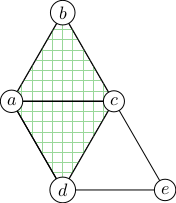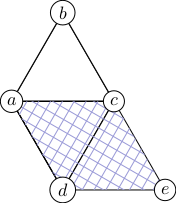| (a) | (b) |
 |
 |
Finding the isometric embedding guaranteed by Alexandrov's theorem in a robust way is presently an unsolved problem: the state-of-the-art uses numerical force-field optimization (Brinkmann et al. 2010, Schwerdtfeger et al. 2013, Wirz et al. 2015), which often works, but it is prone to failure if the initial guess is far from the correct shape, and it breaks down more often as fullerenes grow in size.
This task will start from my recent work presented here. The central idea is as follows: For fullerenes, the positions of the pentagons uniquely determine the fullerene's shape. The idea explored here is to thin out the graph in a certain metric-preserving way by maintaining a Delaunay-triangulation, and to use the surface metric to find the coarse polyhedron defined by the 12 pentagon vertices. The 12-vertex polyhedron can then be embedded in a robust way (and uniquely, by Alexandrov) due to the fixed vertex count.
| (a) | (b) |
 |
 |
Computing the Delaunay triangulation is made difficult by the fact that it isn't possible to make a single two-dimensional coordinate system for the whole fullerene surface. However, it is possible to make overlapping patches of flat coordinate systems. In particular, any two adjacent triangles share a coordinate system, and this can be extended to regions that contain no Gaussian curvature. Inside such regions, angles and lengths can be worked out as in Cartesian coordinates, but anything that goes outside of the ``safe'' region potentially yields nonsense. The information used in the Delaunay triangulation algorithm has to, in each step, remain within the progressively growing flat regions.
The subtasks for Task E include: